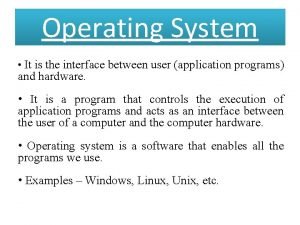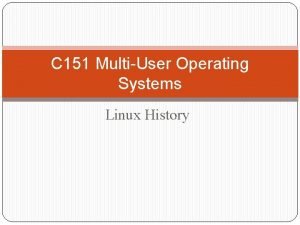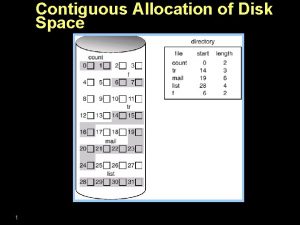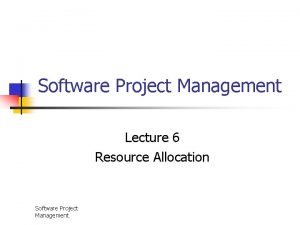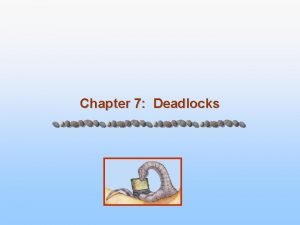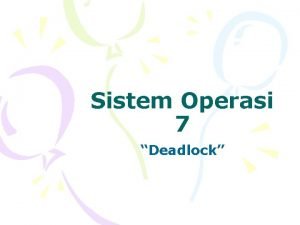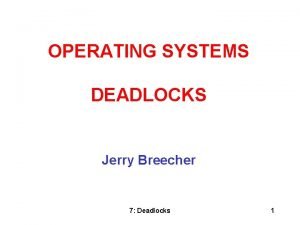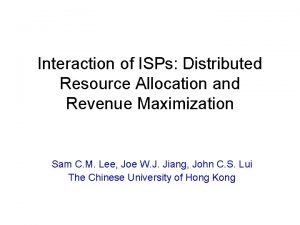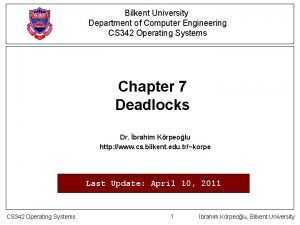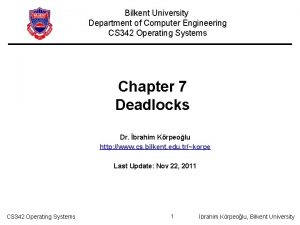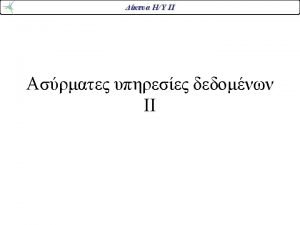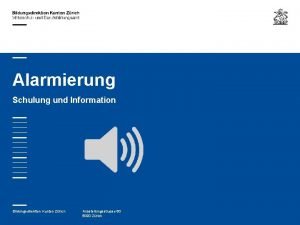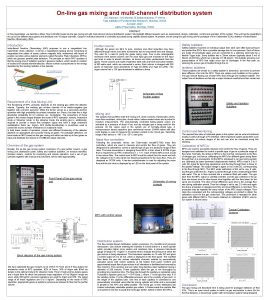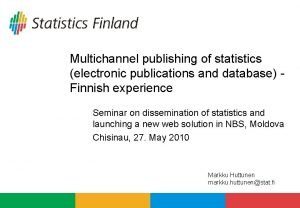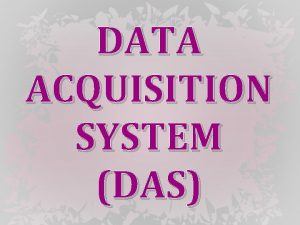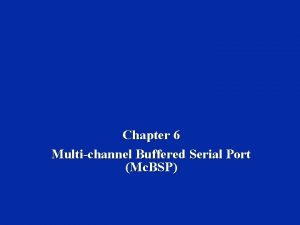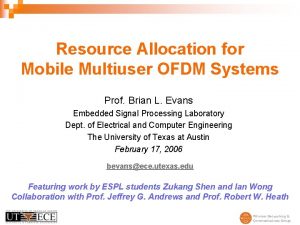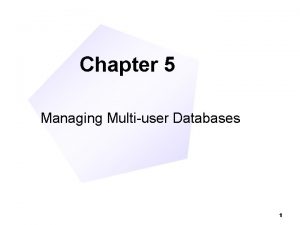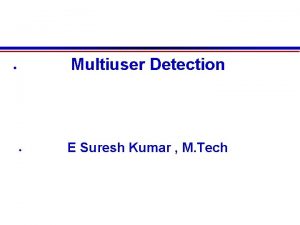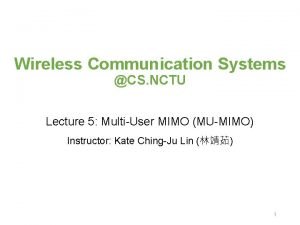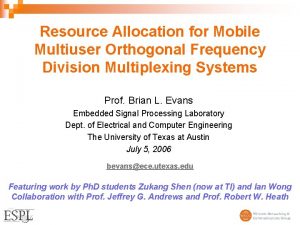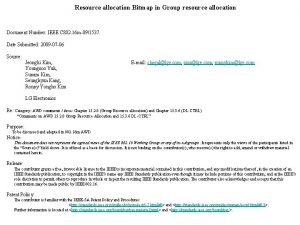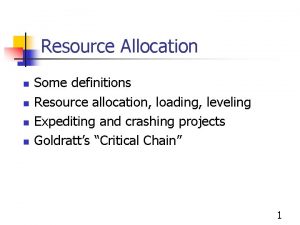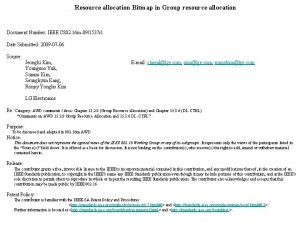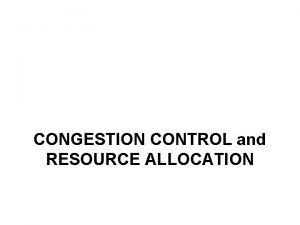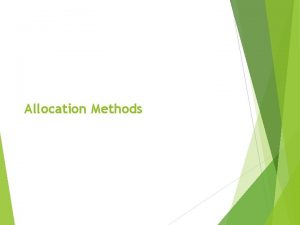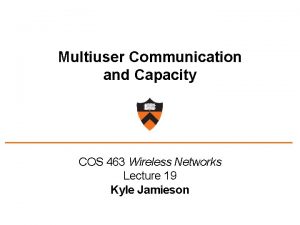Multiuser Resource Allocation in Multichannel Wireless Communication Systems







![MU-OFDM Adaptive Resource Allocation Objective Max sum capacity [Jang et al. , 2003] Max MU-OFDM Adaptive Resource Allocation Objective Max sum capacity [Jang et al. , 2003] Max](https://slidetodoc.com/presentation_image/3ece46193f2c45532b9219587b85f911/image-8.jpg)

![Contribution #1 Subchannel Allocation v Modified method of [Rhee et al. , 2000], but Contribution #1 Subchannel Allocation v Modified method of [Rhee et al. , 2000], but](https://slidetodoc.com/presentation_image/3ece46193f2c45532b9219587b85f911/image-10.jpg)






















- Slides: 32

Multiuser Resource Allocation in Multichannel Wireless Communication Systems Zukang Shen Ph. D. Defense Committee Members: Prof. Jeffrey G. Andrews (co-advisor) Prof. Melba M. Crawford Prof. Gustavo de Veciana Prof. Brian L. Evans (co-advisor) Prof. Robert W. Heath, Jr. Prof. Edward J. Powers Communications, Networks, and Systems Area Dept. of Electrical and Computer Engineering The University of Texas at Austin Jan. 19, 2006 (updated slides)

Outline Contribution #1: Multiuser orthogonal frequency division multiplexing #2: Multiuser multiantenna systems with block diagonalization #3: User selection in multi-antenna systems with block diagonalization Multichannel Objective Frequency domain Spatial domain New Low Complexity Constraints Algorithm Sum capacity Proportional user data rates Decouple subchannel and power allocation Sum capacity Joint precoding and postprocessing Receive antenna selection Sum capacity Systems with a large number of users Greedy capacity and channel norm based algorithms 2

Resource Allocation in Wireless Systems v High data rate transmission Ø Wireless local area networks (WLAN) 54 -- 108 Mbps Ø Metropolitan area networks (Wi. MAX) ~10 -- 100 Mbps Ø Cellular systems (3 GPP) ~1 -- 4 Mbps v Limited resources shared by multiple users Transmit power Frequency bandwidth Transmission time Code resource Spatial antennas frequency code/spatial Ø Ø Ø user 4 user 5 user 6 v Resource allocation impacts user 1 Ø Power consumption Ø User throughput Ø System latency user 2 user 3 time 3

Multiuser Diversity v Multiuser wireless communication systems Resource Allocation Static Adaptive Users transmission order Predetermined Smartly scheduled Channel state information Not exploited Well exploited System Performance Poor Good 4 time/frequency Ø Independent fading channels Ø Multiuser diversity user 1 user 2 user 3 user K time/frequency

Downlink Multiuser Multichannel Systems v Downlink systems Ø Centralized basestation transmits to multiple users simultaneously Ø Limited resources at basestation v Multiple channels created in Ø Frequency: orthogonal frequency division multiplexing (OFDM) Ø Space: multiple transmit and receive antennas v Adaptive resource allocation Ø Goal: Optimize system throughput subject to constraints Ø Method: Formulate resource allocation as optimization problem q Optimal solution typically computationally prohibitive to find q Low complexity resource scheduling algorithms desired Ø Assumption: Perfect channel state information of all users known at basestation 5

Outline v Introduction v Contribution #1: Adaptive resource allocation in multiuser OFDM systems with proportional rate constraints Ø Optimization framework balancing throughput and fairness Ø Decoupling subchannel and power allocation Ø Allocating power optimally for a given subchannel allocation v Contribution #2: Sum capacity of downlink multiuser MIMO systems with block diagonalization v Contribution #3: Low complexity user selection algorithms in multiuser MIMO systems with block diagonalization v Conclusion 6

Multiuser OFDM (MU-OFDM) v Orthogonal frequency division multiplexing Ø Zero inter-symbol interference Ø Parallel frequency subchannels Ø Multiple access technology v Downlink multiuser OFDM gain frequency Ø Users share subchannels and basestation transmit power Ø Users only decode their own data v Resource allocation methods Ø Static: TDMA, FDMA Ø Dynamic: multiuser diversity q Users feedback channel information to basestation q Basestation determines resource allocation 7
![MUOFDM Adaptive Resource Allocation Objective Max sum capacity Jang et al 2003 Max MU-OFDM Adaptive Resource Allocation Objective Max sum capacity [Jang et al. , 2003] Max](https://slidetodoc.com/presentation_image/3ece46193f2c45532b9219587b85f911/image-8.jpg)
MU-OFDM Adaptive Resource Allocation Objective Max sum capacity [Jang et al. , 2003] Max minimum user’s capacity [Rhee et al. , 2000] Advantage Disadvantage Best sum capacity No data rate fairness among users Equal user data rates Inflexible user data rates distribution Data rate fairness No guarantee for adjustable by required proportional varying user data rates weights Max weighted sum capacity [Cendrillon et al. , 2004] : user k’s capacity (bits/s/Hz) as continuous function for single cell 8

Contribution #1 MU-OFDM with Proportional Rates v Objective: Sum capacity B Transmission bandwidth K # of users N # of subchannels pk, n power in user k’s subchannel n hk, n channel gain of user k’s subchannel n N 0 AWGN power density Rk User k’s capacity System parameter for proportional rates v Constraints Ø Total transmit power Ø No subchannel shared by multiple users Ø Proportional rate constraints v Advantages Ø In theory, fill gap of max sum capacity & max-min capacity Ø In practice, allow different service privileges and different pricing 9
![Contribution 1 Subchannel Allocation v Modified method of Rhee et al 2000 but Contribution #1 Subchannel Allocation v Modified method of [Rhee et al. , 2000], but](https://slidetodoc.com/presentation_image/3ece46193f2c45532b9219587b85f911/image-10.jpg)
Contribution #1 Subchannel Allocation v Modified method of [Rhee et al. , 2000], but we keep the assumption of equal power distribution on subchannels 1. Initialization (Enforce zero initial conditions) Set , for. Let 2. For a) Find b) Let 3. While to (Allocate best subchannel for each user) satisfying for all and update , (Then iteratively give lowest rate user first choice) a) Find satisfying b) For the found , find c) For the found and update for all satisfying , Let 10 for all , and

Contribution #1 Power Allocation for a Single User v Optimal power distribution for user Ø Order Ø Water-filling algorithm v How to find for K # of users N # of subchannels pk, n power in user k’s nth assigned subchannel Hk, n Channel-to-noise ratio in user k’s nth assigned subchannel Nk # of subchannels allocated to user k Pk, tot Total power allocated to user k Water-level subchannels 11

Contribution #1 Power Allocation among Many Users v Use proportional rate and total power constraints where v Solve nonlinear system of K equations: v Two special cases Ø Linear case: Ø High channel-to-noise ratio: /iteration , closed-form solution and 12

Contribution #1 Comparison with Optimal Solution 13

Contribution #1 Comparison with Max-Min Capacity 14

Contribution #1 Comparison with Max Sum Capacity 15

Summary of Contribution #1 v Adaptive resource allocation in multiuser OFDM systems Ø Maximize sum capacity Ø Enforce proportional user data rates v Low complexity near-optimal resource allocation algorithm Ø Subchannel allocation assuming equal power on all subchannels Ø Optimal power distribution for a single user Ø Optimal power distribution among many users with proportionality v Advantages Ø Ø Evaluate tradeoff between sum capacity and user data rate fairness Fill the gap of max sum capacity and max-min capacity Achieve flexible data rate distribution among users Allow different service privileges and pricing 16

Outline v Introduction v Contribution #1: Adaptive resource allocation in multiuser OFDM systems with proportional rate constraints v Contribution #2: Sum capacity of downlink multiuser MIMO systems with block diagonalization Ø Block diagonalization with receive antenna selection Ø Sum capacity of BD vs. DPC for given channels Ø Upper bound on the ratio of DPC and BD sum capacity in Rayleigh fading channels v Contribution #3: Low complexity user selection algorithms in multiuser MIMO systems with block diagonalization v Conclusion 17

Multi-Antenna Systems v Exploit spatial dimension with multiple antennas v Improve transmission reliability – diversity Ø Combat channel fading [Jakes, 1974] Ø Combat co-channel interference [Winters, 1984] v Increase spectral efficiency – multiplexing Ø Multiple parallel spatial channels created with multiple antennas at transmitter and receiver [Winters, 1987] [Foschini et al. , 1998] Ø Theoretical results on point-to-point multi-input multi-output (MIMO) channel capacity [Telatar, 1999] v Tradeoff between diversity and multiplexing Ø Theoretical treatment [Zheng et al. , 2003] Ø Switching between diversity and multiplexing [Heath et al. , 2005] 18

MIMO Gaussian Broadcast Channels v Duality with multiple access channels [Vishwanath et al. , 2003] Ø Dirty paper coding (DPC) [Costa, 1983] Ø Sum capacity achieved with DPC [Vishwanath et al. , 2003] Ø Iterative water-filling algorithm [Yu et al. , 2004] [Jindal et al. , 2005] v Capacity region [Weingarten et al. , 2004] v Coding schemes approaching DPC sum capacity [Zamir et al. , 2002] [Airy et al. , 2004] [Stojnic et al. , 2004] Ø Too complicated for cost-effective implementations + Broadcast Channel + + + Multiple Access Channel 19

Block Diagonalization (BD) v Linear precoding technique v Zero inter-user interference [Spencer et al. , 2004] v in the null space of v Advantages: Simple transceiver design Ø Effective point-to-point MIMO channel v Disadvantages: Suboptimal for sum capacity Ø Channel energy wasted for orthogonalizing user channels Ø Transmit signal covariance matrices not optimal 20

Contribution #2 BD with Receive Antenna Selection v Why joint processing? v Confine to be selection matrix, e. g. Ø Lower system overhead for conveying Ø BD with receive antenna selection Ø Exhaustive search for optimal selection matrices 21

Contribution #2 BD vs. DPC: Given Channels v Theorem: The ratio of DPC sum capacity over BD is bounded by Ø Ratio of DPC sum capacity over TDMA bounded by [Jindal et al. , 2005] Ø TDMA only serves one user at a time Ø BD supports multiple users: Ø Valid for any SNR, , , and v Lemma: If user channels are orthogonal, then v Lemma: If and user channels are in same vector space 22

Contribution #2 BD vs. DPC: Rayleigh Fading Channels v Lower bound on BD ergodic sum capacity Ø Fix a subset of users to serve Ø Each user’s effective channel still Rayleigh Ø Equal power allocated for every MIMO eigenmode v Upper bound on DPC ergodic sum capacity Ø Allow user cooperation (effectively point-to-point channel) Ø Cooperative channel Ø Space-time water-filling for effective cooperative MIMO channel v Upper bound on ratio of DPC and BD ergodic sum capacity Ø Easy evaluation with numerical integrations Ø Bound is tight for q Medium to high SNR, or q 23

Contribution #2 Simulation Results 24

Contribution #2 Simulation Results 25

Summary of Contribution #2 v Sum capacity in downlink multiuser MIMO systems with block diagonalization Ø Formulated joint transmitter precoding and receiver post-processing (shown in dissertation) Ø Combined block diagonalization with receive antenna selection v Block diagonalization vs. dirty paper coding Ø Sum capacity for given channels Ø Ergodic sum capacity in Rayleigh fading channel v Block diagonalization achieves a significant part of the optimal sum capacity 26

Outline v Introduction v Contribution #1: Adaptive resource allocation in multiuser OFDM systems with proportional rate constraints v Contribution #2: Sum capacity of downlink multiuser MIMO systems with block diagonalization v Contribution #3: Low complexity user selection algorithms in multiuser MIMO systems with block diagonalization Ø Capacity based user selection Ø Channel Frobenius norm based user selection v Conclusion 27

Need of User Selection for BD v Zero inter-user interference requires Ø Dimension of in null space of : v Maximum number of simultaneous users: Ø Assuming active users utilize all receive antennas v Select subset of users to maximize total throughput v Exhaustive search Ø Optimal for total throughput Ø Computationally prohibitive v Related work Ø Semi-orthogonal user set construction [Yoo et al. , 2005] Ø Antenna selection [Gharavi-Alkhansari et al. , 2004] 28

Contribution #3 Greedy User Selection Algorithms Capacity based algorithm (c-algorithm) Channel norm algorithm (n-algorithm) , apply BD to No No users selected or sum capacity decreases Yes 29 apply c-algorithm to select subset

Contribution #3 Computational Complexity (m x n) complex matrix operation Flop counts Frobenius norm Gram-Schmidt orthogonalization Water-filling algorithm Singular value decomposition v Proposed algorithms have complexity Average CPU run time (Pentium M 1. 6 G Hz PC) 30

Contribution #3 Monte Carlo Results 31

Summary of Contributions v Adaptive resource allocation in multiuser OFDM Ø Balanced throughput and proportional user data rates Ø Derived optimal power allocation given subchannel allocation v Sum capacity of downlink multiuser MIMO systems Ø Combined block diagonalization with receive antenna selection Ø Analyzed sum capacity of BD vs. DPC for given channels Ø Derived upper bound on ratio of DPC and BD sum capacity in Rayleigh fading channels v Low complexity user selection algorithms in multiuser MIMO systems with block diagonalization Ø Proposed two algorithms with linear complexity in no. of total users Ø Achieved near-optimal sum capacity 32
 Resource loading vs resource leveling
Resource loading vs resource leveling Gui is an interface between
Gui is an interface between Xuml
Xuml Multiuser operating system
Multiuser operating system Contiguous allocation vs linked allocation
Contiguous allocation vs linked allocation What are wireless devices and the wireless revolution
What are wireless devices and the wireless revolution Resource requirements example
Resource requirements example Algoritmo banchiere
Algoritmo banchiere Resource histogram
Resource histogram Resource allocation graph and wait for graph
Resource allocation graph and wait for graph Resource allocation graph
Resource allocation graph Resource allocation graph with a deadlock
Resource allocation graph with a deadlock Deadlock
Deadlock Distributed resource allocation
Distributed resource allocation Strategy formulation vs strategy implementation
Strategy formulation vs strategy implementation Ooqqq
Ooqqq Cs 433 bilkent
Cs 433 bilkent Resource allocation graph in os
Resource allocation graph in os Multichannel multipoint distribution service
Multichannel multipoint distribution service Multichannel-alarmierung
Multichannel-alarmierung Multichannel distribution system
Multichannel distribution system Multi-channel publishing system
Multi-channel publishing system Multichannel fundraising
Multichannel fundraising Single channel and multichannel data acquisition system
Single channel and multichannel data acquisition system Marktuntersuchung arbeitsblatt
Marktuntersuchung arbeitsblatt Multi channel retailing definition
Multi channel retailing definition Multi channel retailing definition
Multi channel retailing definition Bufferedserial
Bufferedserial Multichannel adalah
Multichannel adalah Multichannel publishing
Multichannel publishing Multichannel conflict
Multichannel conflict Merchandise assortment planning ppt
Merchandise assortment planning ppt Perbedaan antara resource loading dan resource levelling
Perbedaan antara resource loading dan resource levelling

